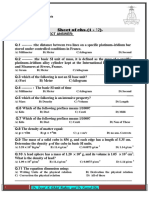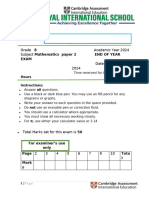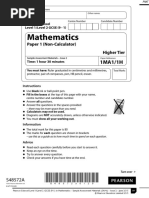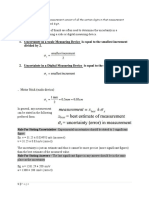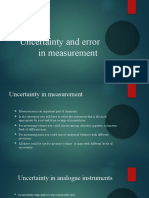Calculating Uncertainties
Uploaded by
Sarwat ShaheenCalculating Uncertainties
Uploaded by
Sarwat ShaheenCalculating Uncertainties
A Quick Guide
What Is An Uncertainty?
No measuring instrument (be it a plastic
ruler or the worlds most accurate
thermometer) is perfectly accurate
When you make any measurement, there
always is some uncertainty as to the exact
value.
For example:
The ruler says this red line is 3.5 cm long
Due to imperfections in the design and
manufacturing of the ruler, I cant be sure that it
is exactly 3.500 cm, just something close to that,
perhaps 3.492. or 3.521
Measuring Uncertainties
Most equipment manufacturers know
the level of uncertainty in their
instruments, and will tell you.
For example:
The instruction manual that came with my
ruler tells me it is accurate to +/- 0.05 cm.
This means my 3.5 cm line is actually
anywhere between 3.45 and 3.55 cm long
Importantly: we have no way of knowing
where in this range the actual length is,
unless we use a more accurate ruler
How Big Are The Uncertainties?
Most good apparatus will have the
uncertainty written on it, so make a
note of it.
Where this is not the case, use half
the smallest division:
For example: if a balance can measure
to two decimal places, the uncertainty
would by +/- 0.005 g
When manually measuring time, you
should round to the nearest whole
second, and decide the uncertainty
based on the nature of your
measurement.
Absolute
Absolute uncertainty is
the actual size of the
uncertainty in the units
used to measure it.
This is what the previous
slide referred to
In our ruler example, the
absolute uncertainty is
+/- 0.05 cm
Relative Uncertainty
and
To minimise absolute
uncertainty, you should
use the most accurate
equipment possible.
This is the size of the uncertainty
relative to the value measured, and
is usually expressed as a percentage
Relative uncertainty can be
calculated by dividing the absolute
uncertainty by the measured value
and multiplying by 100
In our ruler example, the relative
uncertainty is
0.05 / 3.5 x 100 = 1.4%
To minimise relative uncertainty, you
should aim to make bigger
measurements
How do uncertainties affect my
calculations?
If the numbers you are putting into a calculation
are uncertain, the result of the calculation will
be too
You need to be able to calculate the degree of
uncertainty
The Golden Rules:
When adding/subtracting: add the absolute
uncertainty
When multiplying/dividing: add the relative
Example: A Titration
In a titration, the initial reading on my burette was 0.0 cm 3,
and the final reading was 15.7 cm 3. The burette is accurate
to +/- 0.05 cm3. What are the most and least amounts of
liquid I could have added?
The volume of liquid added is the final reading minus the
initial reading, so we need to add absolute uncertainty in
each reading.
Absolute uncertainty = 0.05 + 0.05 = 0.10 cm 3
Most amount = 15.7 + 0.10 = 15.8 cm 3
Least amount = 15.7 - 0.10 = 15.6 cm 3
Example 2: A rate of reaction
In an experiment on the rate of a reaction, a student timed how long
it would take to produce 100 cm3 of gas, at a variety of different
temperatures. At 30OC, it took 26.67 seconds. The gas syringe used
was accurate to +/- 0.25 cm3. What is the average rate of reaction,
and what is the relative uncertainty in this value?
Rate = volume / time = 100 / 27 = 3.70 cm 3s-1
Time is rounded to the nearest whole second as human reaction times do not
allow for 2 decimal places of accuracy
Absolute uncertainty of volume: +/- 0.25 cm 3
Absolute uncertainty of time: +/- 0.5s
This is an approximation, taking into account reaction time and the difficulty
of pressing stop exactly at 100 cm 3.
You should make similar approximations whenever you are manually
recording time, and should write a short sentence to justify them
Example 2 continued
Relative uncertainty of volume
Relative uncertainty of time
% Uncertainty = (absolute uncertainty / measured value) x
100
= 0.25/100 x 100 = 0.25%
% Uncertainty = (0.5 / 27) x 100 = 1.85%
Relative uncertainty of rate
% Uncertainty (rate) = % uncertainty (volume) + %
uncertainty (time)
= 0.25 + 1.85
= 2.10%
The relative uncertainties were added as the rate calculation
required a division calculation
Uncertainty propagation of averages
This is more complicated as we need to make
a choice: the uncertainty is either:
The absolute uncertainty of the measured value
OR
The standard deviation of our data
We must choose whichever is larger
For example
With the previous example, if I did three repeat titrations all accurate to +/0.10 cm3, what is the average titre?
Volume added
(cm3) +/- 0.10
cm3
15.7
15.4
15.9
Absolute uncertainty of measured values = +/- 0.10 cm 3
Standard deviation = +/- 0.25 cm 3
To calculate standard deviation: Calculate the variance by subtracting each value from
the average value, squaring it and then averaging the squared values; now take the
quare root of the variance. See here: http://
www.mathsisfun.com/data/standard-deviation.html
Alternatively use the STDEVP* function in Excel. =STDEVP(Range)
Tria
l
This calculates standard deviation of a population, rather than STDEV which calculates standard
deviation of a sample (see the link above for an explanation of the difference).
The standard deviation is larger than the absolute uncertainty so:
Average titre = (15.7+15.4+15.9)/3 = (15.7 +/- 0.30) cm 3
Some Practice Questions
With a stopwatch you time that it takes a friend 8.5 s (+/- 0.25 s, human
reaction time) to run 50 metres (+/- 0.50 m). If speed = distance / time:
1.
a.
How fast was the friend running?
b.
What is the relative error in the speed?
c.
What are the fastest and slowest possible speeds?
Whilst doing an experiment on density, you find that a lump of material
with a mass of 1.22 g (+/- 0.0010g) has a volume of 0.65 cm3 (+/- 0.05
cm3). If density = mass / volume:
2.
a.
What is the density of the material?
b.
What is the relative error in the density?
c.
What are the highest and lowest possible values for the density?
d.
How could you improve the experiment to reduce the uncertainty in the result?
A candle was burnt and the energy it produced measured. The initial
mass of the candle was 25.1 g (+/- 0.05) grams and the final mass was
22.7 g (+/- 0.05 g). It was found the candle released 80.2 kJ energy (+/1.5 kJ).
3.
a.
Calculate the energy released per gram of wax burnt (energy released/mass of
candle burnt).
b.
Calculate the absolute and relative error in the mass of candle wax burnt.
Answers: Q1 a) 5.67 m/s, b) 3.9%, c) max: 6.13 m/s, min: 5.67 m/s; Q2 a) 1.88 g/cm3, b) 7.8%, c) max:
2.03 g/cm3, min: 1.73 g/cm3, d) measure volume more accurately, and/or use a bigger lump to reduce relative error
in volume; Q3 a) 33.4 kJ/g, b) Abs: +/- 0.10 g, Rel: +/- 4.2%, c) +/- 6.0%, d) max: 75.4 kJ/g, min: 85.0 kJ/g
You might also like
- 7408-1 Specimen Mark Scheme (Set 2) - Paper 1 v1.1No ratings yet7408-1 Specimen Mark Scheme (Set 2) - Paper 1 v1.112 pages
- (Booklet) KS4 Mastery Foundation 1 - QuestionsNo ratings yet(Booklet) KS4 Mastery Foundation 1 - Questions16 pages
- Mark Scheme (Results) January 2019: Pearson Edexcel International GCSE in Further Pure Mathematics (4PM0) Paper 01No ratings yetMark Scheme (Results) January 2019: Pearson Edexcel International GCSE in Further Pure Mathematics (4PM0) Paper 0126 pages
- London GCE O Level Syllabus D June1973-Jan1975No ratings yetLondon GCE O Level Syllabus D June1973-Jan197520 pages
- Outcome 1: VCE Physics SAC: Unit 3 - Outcome 1No ratings yetOutcome 1: VCE Physics SAC: Unit 3 - Outcome 16 pages
- Worksheet On Rotations by Hassan LakissNo ratings yetWorksheet On Rotations by Hassan Lakiss11 pages
- IB Internal Assessment Guide 08 - PhysicsNo ratings yetIB Internal Assessment Guide 08 - Physics13 pages
- June 2017 QP - Paper 1F Edexcel Maths (A) IGCSE0% (1)June 2017 QP - Paper 1F Edexcel Maths (A) IGCSE24 pages
- Buy Ebook Mathematical Methods Units 3 4 For Queensland 1st Edition Michael Evans Cheap Price100% (3)Buy Ebook Mathematical Methods Units 3 4 For Queensland 1st Edition Michael Evans Cheap Price79 pages
- Cambridge O Level: English Language 1123/22No ratings yetCambridge O Level: English Language 1123/2217 pages
- Igcse Combined Science: Paper 0653/01 Multiple ChoiceNo ratings yetIgcse Combined Science: Paper 0653/01 Multiple Choice20 pages
- Std. X - Maths Paper IV - EXTENDED - 1 - Mock-2No ratings yetStd. X - Maths Paper IV - EXTENDED - 1 - Mock-216 pages
- IGCSE Maths CE 0580 0980 SB Quick Revision GuideNo ratings yetIGCSE Maths CE 0580 0980 SB Quick Revision Guide19 pages
- Edexcel IAS Pure MathematicsP1-P2 WMA11-WMA12 Formula SheetNo ratings yetEdexcel IAS Pure MathematicsP1-P2 WMA11-WMA12 Formula Sheet17 pages
- AS Maths Tutorial - Pure (Linked To Textbook)No ratings yetAS Maths Tutorial - Pure (Linked To Textbook)1 page
- 9630 PH01 International As Physics Specimen Paper 2016 v2No ratings yet9630 PH01 International As Physics Specimen Paper 2016 v224 pages
- AQA IGCSE Further Maths Revision Notes: 1. NumberNo ratings yetAQA IGCSE Further Maths Revision Notes: 1. Number16 pages
- Mark Scheme (Results) January 2020: Pearson Edexcel International GCSE in Chemistry (4CH1) Paper 2CR75% (8)Mark Scheme (Results) January 2020: Pearson Edexcel International GCSE in Chemistry (4CH1) Paper 2CR14 pages
- V Best Chapter 1.1 Quadratics - ONLINE PDFNo ratings yetV Best Chapter 1.1 Quadratics - ONLINE PDF16 pages
- Mathematical Methods Units 1 2 For Queensland 1st Edition Michael Evans Ebook All Chapters PDF100% (3)Mathematical Methods Units 1 2 For Queensland 1st Edition Michael Evans Ebook All Chapters PDF79 pages
- MYP5-Math Unit 1 Term1 Tasksheet 5 2023-24 - NetworkNo ratings yetMYP5-Math Unit 1 Term1 Tasksheet 5 2023-24 - Network6 pages
- Specimen QP - Paper 1 (H) Edexcel Maths GCSENo ratings yetSpecimen QP - Paper 1 (H) Edexcel Maths GCSE20 pages
- Cambridge O Level: Mathematics (Syllabus D) 4024/22No ratings yetCambridge O Level: Mathematics (Syllabus D) 4024/229 pages
- Uncertainities and Errors in MeasurementNo ratings yetUncertainities and Errors in Measurement17 pages
- Manual Densito - DA-650 - 645 - 640 Operation Manual Ver02No ratings yetManual Densito - DA-650 - 645 - 640 Operation Manual Ver0284 pages
- Determination of Partial Molal Volume of KCL in Aqueous Solution100% (2)Determination of Partial Molal Volume of KCL in Aqueous Solution4 pages
- Complete Answer Guide for Test Bank for Physics for Scientists and Engineers with Modern Physics, 10th Edition, Raymond A. Serway, John W. Jewett92% (12)Complete Answer Guide for Test Bank for Physics for Scientists and Engineers with Modern Physics, 10th Edition, Raymond A. Serway, John W. Jewett44 pages
- Gen Phy1 Module1 - Units Physical Quantities Measurement - Version3No ratings yetGen Phy1 Module1 - Units Physical Quantities Measurement - Version332 pages
- Student Exploration: Density Laboratory: Vocabulary: Buoyancy, Density, Graduated Cylinder, Mass, Matter, Scale, VolumeNo ratings yetStudent Exploration: Density Laboratory: Vocabulary: Buoyancy, Density, Graduated Cylinder, Mass, Matter, Scale, Volume6 pages
- Selection and Sizing of Pressure Relief ValvesNo ratings yetSelection and Sizing of Pressure Relief Valves21 pages
- Sekolah Menengah All Saints, Kota Kinabalu Yearly Lesson Plan Form 1 (2018)No ratings yetSekolah Menengah All Saints, Kota Kinabalu Yearly Lesson Plan Form 1 (2018)25 pages
- Concrete Formwork Loads and Pressure CalculationsNo ratings yetConcrete Formwork Loads and Pressure Calculations4 pages
- Fractal Approach To Large-Scale Galaxy Distribution: Yurij Baryshev and Pekka TeerikorpiNo ratings yetFractal Approach To Large-Scale Galaxy Distribution: Yurij Baryshev and Pekka Teerikorpi95 pages
- Selina Solutions For Class 9 Physics Chapter 5 Upthrust in Fluids Archimedes Principle and FloatationNo ratings yetSelina Solutions For Class 9 Physics Chapter 5 Upthrust in Fluids Archimedes Principle and Floatation33 pages
- DEAS 67-2018 Raw Cow Milk - Specification and MethodsNo ratings yetDEAS 67-2018 Raw Cow Milk - Specification and Methods16 pages
- 7408-1 Specimen Mark Scheme (Set 2) - Paper 1 v1.17408-1 Specimen Mark Scheme (Set 2) - Paper 1 v1.1
- Mark Scheme (Results) January 2019: Pearson Edexcel International GCSE in Further Pure Mathematics (4PM0) Paper 01Mark Scheme (Results) January 2019: Pearson Edexcel International GCSE in Further Pure Mathematics (4PM0) Paper 01
- Buy Ebook Mathematical Methods Units 3 4 For Queensland 1st Edition Michael Evans Cheap PriceBuy Ebook Mathematical Methods Units 3 4 For Queensland 1st Edition Michael Evans Cheap Price
- Igcse Combined Science: Paper 0653/01 Multiple ChoiceIgcse Combined Science: Paper 0653/01 Multiple Choice
- Edexcel IAS Pure MathematicsP1-P2 WMA11-WMA12 Formula SheetEdexcel IAS Pure MathematicsP1-P2 WMA11-WMA12 Formula Sheet
- 9630 PH01 International As Physics Specimen Paper 2016 v29630 PH01 International As Physics Specimen Paper 2016 v2
- Mark Scheme (Results) January 2020: Pearson Edexcel International GCSE in Chemistry (4CH1) Paper 2CRMark Scheme (Results) January 2020: Pearson Edexcel International GCSE in Chemistry (4CH1) Paper 2CR
- Mathematical Methods Units 1 2 For Queensland 1st Edition Michael Evans Ebook All Chapters PDFMathematical Methods Units 1 2 For Queensland 1st Edition Michael Evans Ebook All Chapters PDF
- MYP5-Math Unit 1 Term1 Tasksheet 5 2023-24 - NetworkMYP5-Math Unit 1 Term1 Tasksheet 5 2023-24 - Network
- Cambridge O Level: Mathematics (Syllabus D) 4024/22Cambridge O Level: Mathematics (Syllabus D) 4024/22
- Manual Densito - DA-650 - 645 - 640 Operation Manual Ver02Manual Densito - DA-650 - 645 - 640 Operation Manual Ver02
- Determination of Partial Molal Volume of KCL in Aqueous SolutionDetermination of Partial Molal Volume of KCL in Aqueous Solution
- Complete Answer Guide for Test Bank for Physics for Scientists and Engineers with Modern Physics, 10th Edition, Raymond A. Serway, John W. JewettComplete Answer Guide for Test Bank for Physics for Scientists and Engineers with Modern Physics, 10th Edition, Raymond A. Serway, John W. Jewett
- Gen Phy1 Module1 - Units Physical Quantities Measurement - Version3Gen Phy1 Module1 - Units Physical Quantities Measurement - Version3
- Student Exploration: Density Laboratory: Vocabulary: Buoyancy, Density, Graduated Cylinder, Mass, Matter, Scale, VolumeStudent Exploration: Density Laboratory: Vocabulary: Buoyancy, Density, Graduated Cylinder, Mass, Matter, Scale, Volume
- Sekolah Menengah All Saints, Kota Kinabalu Yearly Lesson Plan Form 1 (2018)Sekolah Menengah All Saints, Kota Kinabalu Yearly Lesson Plan Form 1 (2018)
- Fractal Approach To Large-Scale Galaxy Distribution: Yurij Baryshev and Pekka TeerikorpiFractal Approach To Large-Scale Galaxy Distribution: Yurij Baryshev and Pekka Teerikorpi
- Selina Solutions For Class 9 Physics Chapter 5 Upthrust in Fluids Archimedes Principle and FloatationSelina Solutions For Class 9 Physics Chapter 5 Upthrust in Fluids Archimedes Principle and Floatation
- DEAS 67-2018 Raw Cow Milk - Specification and MethodsDEAS 67-2018 Raw Cow Milk - Specification and Methods





